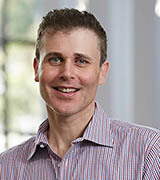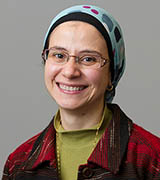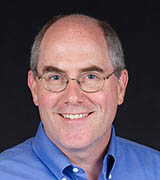Colleagues: Recently Tenured
Meet your recently tenured colleagues: James A. Bourne (NIMH and NINDS), Hans Elmlund (NCI-CCR), Shahinaz Gadalla (NCI-DCEG), Christopher Hourigan (NHLBI), and Andrew L. Mammen (NIAMS).
JAMES A. BOURNE, PH.D., NIMH and NINDS
Senior Investigator and Chief, Section on Cellular and Cognitive Neurodevelopment, National Institute of Mental Health; Adjunct Investigator, National Institute of Neurological Disorders and Stroke

Education: Imperial College of Science, Technology and Medicine, London (B.Sc. in biochemistry); King’s College, London (Ph.D. in neuropharmacology)
Training: Postdoctoral fellowships in the Vision, Touch and Hearing Research Institute, University of Queensland (Brisbane, Australia); and in the Department of Physiology, Monash University, Australia (Clayton, Australia)
Before coming to NIH: Group leader and professor of neurobiology, Australian Regenerative Medicine Institute, Monash University
Came to NIH: In May 2022
Outside interests: Having recently arrived from Australia, he, his partner, and their Cavapoo Charlie (who rides in a backpack) enjoy exploring the Washington, D.C., metropolitan area via bicycle, courtesy of Capital Bikeshare; their favorite weekend activity is to cycle in the early morning along the Capital Crescent Trail to D.C. for brunch.
Research interests: I am fascinated by how reliably and capably the brain develops so it can enable complex behaviors. Neurodevelopment, however, is an area of neuroscience that is often overlooked in terms of trying to define the substrate and cause of neurological and psychiatric disorders. Moreover, there is often considerable focus on a single species being representative of the evolution of specific processes. Therefore, my overarching research goal is to probe how the mammalian brain becomes interconnected. I am also exploring the neural substrate of certain diseases and conditions through the developmental lens.
We are particularly interested in the pulvinar nuclei of the thalamus, which has expanded in size, complexity, and function throughout mammalian evolution; some nuclei are specific to nonhuman primates. (The pulvinar in the thalamus is associated with the processing of visual information.) We are taking a multitechnique approach to explore the development of thalamocortical circuits and their plasticity into adulthood. This approach has the potential to identify the neural underpinnings of disorders, including schizophrenia, autism, and cortical blindness (total or partial loss of vision caused by damage to the brain’s occipital lobe), as well as help us understand how the brain differentially operates at different stages of life.
Through a multidisciplinary cell-to-system approach, my group has influenced views on the developmental organization and plasticity of the primate visual system and how perturbations to specific areas of the brain during particular periods of development can have lifelong implications for visually guided behaviors (Proc Nat Acad Sci U S A 115:1364–1369, 2018). I am pleased to be continuing that work at NIH.
HANS ELMLUND, PH.D., NCI-CCR
Senior Investigator and Head, Biological Computing Section, Center for Structural Biology, Center for Cancer Research, National Cancer Institute

Education: University of Southern Stockholm, Stockholm (B. Sc. in physical chemistry); Royal Institute of Technology, Stockholm (Ph.D. in structural biotechnology)
Training: Postdoctoral fellow, Gothenburg University (Gothenburg, Sweden); postdoctoral fellow, Department of Structural Biology, Stanford University School of Medicine (Palo Alto, California)
Before coming to NIH: Tenured Senior Research Fellow, Biomedicine Discovery Institute, Monash University (Clayton, Australia)
Came to NIH: In October 2021
Website: https://irp.nih.gov/pi/hans-elmlund
Research interests: I started my scientific career using a 300,000-volt helium-cooled electron microscope (EM) to image biological molecules operating as “machines” inside cells. I quickly realized that available computational methods were limiting progress and started to write my own specialized computer code—an open-source program package called SIMPLE—to transform 2D EM images into 3D structures of biomolecules at near-atomic resolution.
In 2014, I established an independent group at the Biomedicine Discovery Institute at Monash University. We began developing game-changing new technologies for 3D structure determination and time-series analysis of movies obtained with aberration-corrected transmission EM of individual nanoparticles tumbling in solution (Science 349:290–295, 2015; Science 368:60–67, 2020; Science Adv 7:eabe6679, 2021). We also developed algorithms that allowed 3D reconstruction of biomolecules at near-atomic resolution in a matter of hours, using standard desktop computers (Structure 24:988–996, 2016; Protein Sci 1:51–61, 2017; J Struc Biol 204:172–181, 2018; Bioinformatics 36:2237–2243, 2019; J Struc Biol 4:100040, 2020).
At NIH, my group is designing algorithms that make unsupervised decisions about how to collect the data and create “intelligent” microscopes via direct feedback between analysis and instrument. We are also developing algorithms for atomic-resolution structure identification of nanocrystals. Our work will allow the translation of structure into function at the cellular and organism levels, which could lead to conceptual advances in a range of biological research fields.
SHAHINAZ GADALLA, PH.D., NCI-DCEG
Senior Investigator, Clinical Genetics Branch, Division of Cancer Epidemiology and Genetics, National Cancer Institute

Education: Ain Shams University School of Medicine, Cairo, Egypt (M.D.); University of Maryland, Baltimore (M.S. in epidemiology and preventive medicine; Ph.D. in epidemiology)
Training: Cancer Prevention Fellow, NCI-DCEG
Came to NIH: In 2007 to complete Ph.D. dissertation; in 2008 joined NCI’s Cancer Prevention Fellowship Program for postdoctoral training; promoted to staff scientist in 2011; became Earl Stadtman investigator in 2014
Outside interests: Spending time with the family; cooking
Website: https://irp.nih.gov/pi/shahinaz-gadalla
Research interests: Myotonic dystrophy (DM) is a slowly progressive multisystem genetic disorder that represents the most common type of adult-onset muscular dystrophy group of diseases. People with this disorder experience progressive muscle wasting and weakness, and, often, prolonged muscle contractions (myotonia)—such as being unable to release their grip on a doorknob, having slurred speech, or having temporary locking of their jaw.
I published the first epidemiological evidence that patients with DM are susceptible to colon, endometrium, ovary, brain, or possibly thyroid cancers (JAMA 306:2480–2486, 2011). My research today focuses on identifying individuals with DM who are at high risk for these cancers and discovering predictive and prognostic biomarkers that may guide therapeutic decisions.
I am also studying severe aplastic anemia (in which the body stops producing enough red blood cells, leaving the person fatigued and more prone to infections) and myeloid neoplasms (bone-marrow cancers). Treatments for these diseases might include medications, blood transfusions, and in most cases hematopoietic-cell transplant (HCT), also known as a bone-marrow transplant.
In 2014, I discovered that after HCT, young patients with severe aplastic anemia had a higher chance of survival when the donor leukocytes had longer telomeres (JAMA 313:594–602, 2015). In my current research, I am investigating markers of cellular aging, germline genetic variants, and somatic copy-number alterations.
In addition to my work at NIH, I am also an adjunct assistant professor of epidemiology and public health at the University of Maryland School of Medicine (Baltimore).
CHRISTOPHER HOURIGAN, M.D., D.PHIL., NHLBI
Senior Investigator and Chief, Laboratory of Myeloid Malignancies, National Heart, Lung, and Blood Institute

Education: Swarthmore College, Swarthmore, Pennsylvania (B.A. in biology); Manchester University, Manchester, England (M.S. in immunology and immunogenetics); University of Oxford, Oxford, England (B.M., B.Ch., D.Phil., and D.M)
Training: Residency in medicine and surgery at Guy’s and St. Thomas’ Hospital (London); residency in internal medicine at Johns Hopkins Bayview Medical Center (Baltimore); clinical fellow in medical oncology and research fellow in cancer immunotherapy at Johns Hopkins Hospital (Baltimore); clinical fellow in hematology at NHLBI
Came to NIH: In 2012 as clinical fellow and assistant clinical investigator; became tenure-track investigator in 2015; in 2022 became tenured senior investigator and co-director of the Trans-NIH Myeloid Malignancies Program
Outside interests: Spending time with his wife, Suchitra Hourigan (a pediatric gastroenterologist and new Lasker Clinical Research Scholar at the National Institute of Allergy and Infectious Diseases), and their two sons
Website: https://irp.nih.gov/pi/christopher-hourigan
Research interests: I was a scientist before I became a physician. I was amazed to find how often only limited and poor-quality information was available for even the most important of medical decisions. While we aspire to apply scientific insights for personalized and precision medicine, particularly when caring for those suffering from cancer, the reality is that clinically we are often working with “best guesses, on average” rather than certainty for the person in front of us.
“Am I cured now, doc, or will this cancer come back?” is a question asked by my patients who have acute myeloid leukemia (AML), a rare, highly fatal blood cancer. AML is diagnosed in 21,000 Americans a year and only around 1 out of 3 survive it. While many have an apparently good response to initial treatment (a “complete” remission), that illusion is often shattered when the cancer becomes evident again (“relapse”) within months despite the best available treatment. My research has focused on why remissions represent a cure only for some.
My team and I have studied patients with AML in clinical remission using highly sensitive and specific genomic tools to detect evidence of very low amounts of this blood cancer associated with higher risks of relapse. We were the first to show, using a NIH-funded randomized phase 3 trial, that early intervention in patients with AML with detectable “subclinical” measurable residual disease (MRD) could improve survival (J Clin Oncol 38:1273–1284, 2019). This MRD concept is now the basis for a personalized medicine approach to AML in several new nationwide therapeutic and disease-monitoring initiatives that I now lead (https://clinicaltrials.gov/ct2/show/NCT05224661).
In addition to predicting AML relapses, we also worked on preventing and treating them. I performed several immunotherapy clinical trials—including one using a novel combination regimen—at the NIH Clinical Center. I also remain a faculty member on the acute leukemia service of Johns Hopkins Hospital where I trained. I have found continuing to care for patients with this horrible disease is both motivating and helps keep the focus on what is most important.
Ultimately, I work at the NIH as a physician–scientist because I want to use science to make medicine better. My hope is that better information will allow us to provide evidence-based, personalized, and effective treatment for patients with cancer.
ANDREW L. MAMMEN, M.D., PH.D., NIAMS
Senior Investigator and Muscle Disease Unit Leader, National Institute of Arthritis and Musculoskeletal and Skin Diseases

Education: Reed College, Portland, Oregon (B.A.in biology); Johns Hopkins University School of Medicine, Baltimore (M.D. and Ph.D. in neuroscience)
Training: Residency in neurology, fellowship in neuromuscular medicine, and research fellowship in rheumatology at Johns Hopkins Hospital
Before coming to NIH: Associate professor of neurology and medicine, Johns Hopkins University School of Medicine
Came to NIH: In 2014
Outside interests: Hiking; reading; traveling
Website: https://irp.nih.gov/pi/andrew-mammen
Research interests: My research focuses on myositis, a rare family of autoimmune diseases in which the body’s own immune system attacks healthy muscle tissue, causing inflammation, weakness, fatigue, and pain in skeletal muscles. Myositis is often accompanied by problems that affect the skin, lungs, and joints. In particular, my team studies dermatomyositis, which can include a skin rash; the anti-synthetase syndrome, which can include rash, lung disease, and arthritis; inclusion body myositis, which typically affects the muscles of older adults; and immune-mediated necrotizing myopathy, which can cause especially severe weakness in children and adults alike.
When I was on the faculty at Johns Hopkins, I co-founded the Johns Hopkins Myositis Center in 2007. My Hopkins colleagues and I discovered a form of immune-mediated necrotizing myopathy that can be triggered by statins, a type of medication used to lower cholesterol concentrations (Arthritis Rheum 63:713–721, 2011). This disease occurs in approximately 1 in 50,000 Black and white Americans who are exposed to statins. However, working with colleagues in New Mexico, I found that members of the Navajo Nation are much more likely to develop this disease (Arthritis Rheum 2022; DOI:10.1002/art.42126; online ahead of print). Indeed, approximately 1 in 300 of these American Indians may develop this form of myositis if exposed to statins. We are currently trying to understand why some people can safely use statins while others are at an increased risk of developing myositis and should avoid this type of cholesterol-lowering medication.
At NIH, my lab is 1) defining the different subtypes of autoimmune muscle disease based on muscle histology, autoantibodies, and other biomarkers; 2) elucidating the role of myositis autoantibodies in the pathogenesis of myositis; 3) developing animal models of myositis that are relevant to the human diseases; 4) understanding how environmental exposures, including medications such as statins and cancer immunotherapies, can trigger autoimmune muscle disease, and 5) using novel therapeutic strategies to treat myositis patients at the NIH Clinical Center.
In addition to seeing myositis patients at the NIH Clinical Center, I am an adjunct professor of neurology and medicine at Hopkins, where I continue to see patients at the Myositis Center.
This page was last updated on Monday, September 19, 2022
